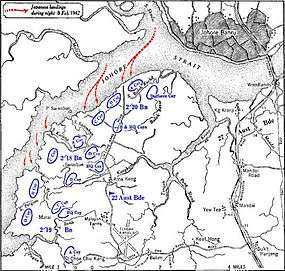Battle of Sarimbun Beach
| Battle of Sarimbun Beach | |||||||
|---|---|---|---|---|---|---|---|
| Part of the Battle of Singapore, Pacific War | |||||||
 The positions of Allied forces in the Sarimbun area of Singapore at 10.00pm (local time) on 8 February in 1942. The arrows indicate attacks by Japanese forces. | |||||||
| |||||||
| Belligerents | |||||||
|
|
| ||||||
| Commanders and leaders | |||||||
|
|
| ||||||
| Strength | |||||||
| ~3,000 | ~10,000 | ||||||
| Casualties and losses | |||||||
| Unknown, possibly significant | Unknown, possibly light | ||||||
The Battle of Sarimbun Beach was the first stage of the Japanese assault on Singapore in February 1942 during World War II. Sarimbun Beach, located in the northwestern corner of mainland Singapore, was the area in which Japanese troops, under the overall direction of Lieutenant-General Tomoyuki Yamashita, first attacked Allied forces (predominantly British) in Singapore. The overall commander of all Allied forces in Singapore, Lieutenant-General Arthur Percival, did not expect the Japanese to make their main attack on the island from the northwest and subsequently failed to reinforce the later-beleaguered Australian 22nd Brigade, which took the brunt of the Japanese assault. The main Japanese objective to be attained following their landing at Sarimbun Beach was the capture of Tengah Airfield.
Background
In the lead up to the invasion, Percival gave Major-General Gordon Bennett's two brigades, from the Australian 8th Division, responsibility for the north-western sector of the island, which including the prime invasion points. The terrain was primarily mangrove swamp and tropical forest, broken up by rivers and creeks. Brigadier Harold Taylor's 22nd Infantry Brigade, augmented by most of the Australian 2/4th Machine Gun Battalion, was assigned a 10-mile (16 kilometre) wide sector centred on Sarimbun Beach. The Jind Infantry Battalion of the Indian States Forces, which was guarding Tengah, and a company from Dalforce, a guerilla militia recruited from Singaporean Chinese. The 27th Infantry Brigade was assigned an adjoining 4,000 yard (3,650m) wide zone to the north, adjoining the causeway. The Australian 2/4th Machine Gun Battalion was distributed among the infantry units.
Battle
At 8.30pm on 8 February, following detection and confirmation, Australian machine-gunners opened fire on vessels carrying the first wave of 4,000 Japanese troops from the IJA's 5th and 18th Divisions towards Singapore Island. The Japanese wasted no time in assaulting Sarimbun Beach, which was held in defence by the 22nd Brigade.
Fierce fighting raged throughout the night in the area but the increasing Japanese strength in numbers — as well as their superiority in artillery, tanks, planes and military intelligence — eventually began to take their toll on the ill-reinforced defenders. The Japanese managed to exploit several gaps in the thinly-spread Allied defence line along the coast, such as via small rivers, streams and creeks. By midnight, the two Australian brigades involved in the defence of the beach had lost communications with each other and the 22nd Brigade was forced to retreat in confusion. At 1.00am, yet more Japanese troops were landed and the last Australian reserves went into the fray of the battle.
Towards dawn on 9 February, some elements of the 22nd Brigade had been overrun or surrounded by the invaders and the 2/18th Australian Infantry Battalion, positioned in the centre, had lost more than half of its personnel. The 2/20th Australian Infantry Battalion, holding on to the right flank, was also heavily committed in resisting the Japanese troops. At the same time, the 2/19th Australian Infantry Battalion, to the left side, was being outflanked, and only "B" Company was left to face the initial landings and assaults by the Japanese.
Percival continued to maintain a belief that further landings by the invading forces would eventually occur in the northeast and did not agree to reinforce the badly-weakened 22nd Brigade until Tengah Airfield itself was threatened with the nearby presence of the Japanese troops which were just landed. However, before limited British and Indian infantry reinforcements arrived, the badly-battered Australian and Singaporean defence units, along with the Jinds, had already retreated to take up new defence positions on the so-called "Jurong Line", stretching south from the village of Bulim, located to the east of the airfield. Tengah Airfield was finally taken by the Japanese at around mid-day on 9 February, thus fulfilling their key objective for the landings at Sarimbun.
Aftermath
Shortly after dark on 9 February, three British Fairmile B motor launches were sent on a raid up the western channel of the Straits of Johor at the area of the coastline adjoining Sarimbun Beach. Their primary objective was to attack Japanese landing-craft and disrupt enemy communications. They came under fire from enemy forces on both shores (coming from Malaya to the north and Sarimbun Beach to the south) but pressed on almost as far as the Causeway. A few Japanese landing-craft were successfully destroyed and sunk before the launches returned down the channel and reaching Singapore safely while suffering minimal to almost no damage. Some Allied soldiers saw this as an example of effective defensive tactics that were used too little and/or too late by their senior commanders.
See also
References
- Lionel Wigmore, 1957, Australia in the War of 1939–1945, Volume IV — The Japanese Thrust, (1st ed.; Australian War Memorial: Canberra).
- Frank Owen, 2001, The Fall of Singapore, Penguin Books, ISBN 0-14-139133-2
External links
- Wigmore, 1957, Australia in the War of 1939–1945, Volume IV — The Japanese Thrust, "Chapter 15 — Defence of Western Area" (1st ed.; Australian War Memorial, Canberra)
- Germaine Foo-Tan, 2004, "1942 — Sarimbun Beach Battle" (Singapore Ministry of Defence).